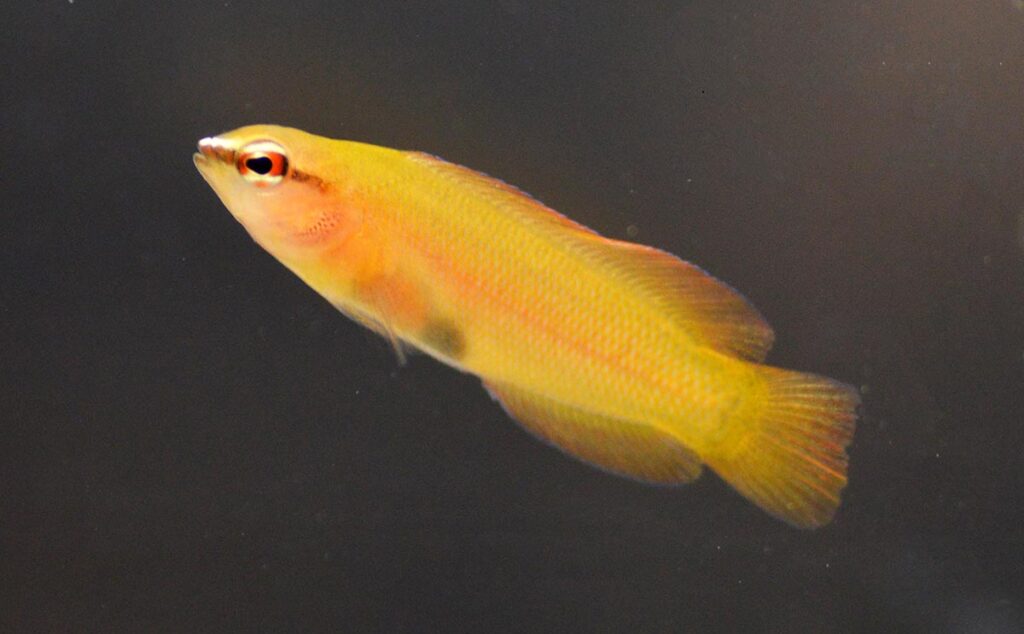
By Tom Verhoeven, Nursery Manager and Marine Biologist at De Jong Marinelife
As a marine biologist and fish breeder, I have been privileged to build a new fish hatchery for De Jong Marinelife in the Netherlands. Although De Jong Marinelife is a commercial company, distributing marine ornamental fish in the aquarium trade, we are making substantial investments in science, sustainability, research, and the future.
In order to secure our hobby for the future, we are actively creating and expanding a unique broodstock department. Our overarching goal is to create a bridge to the future, working to gather and maintain a higher number of species to offer as a captive-bred, sustainable option. We also hope to maintain the diversity of our offerings should the importation of wild fish no longer be permitted.
In our quest to expand our broodstock collection, we are looking for new species but also new wild genetic input to create a healthy broodstock repository. In 2022, we were able to organize a few imports from the country of Oman. From these shipments, we obtained new wild genetics for the popular Neon Dottyback, Pseudochromis aldabraensis. These imports also enabled us to acquire unique species like the hyper-rare Oman Clownfish, Amphiprion omanensis, a species basically unknown to the aquarium trade and hobby.
In one of these shipments, we knew that a dottyback species was being included; we only had the genus Pseudochromis for identification. We started investigating the possibilities by entering search terms into Google like “Dottyback Oman”. Based in the initial results, we were confident we would receive Pseudochromis omanensis, a tan to brownish species adorned with fine, electric blue dots and facial markings.
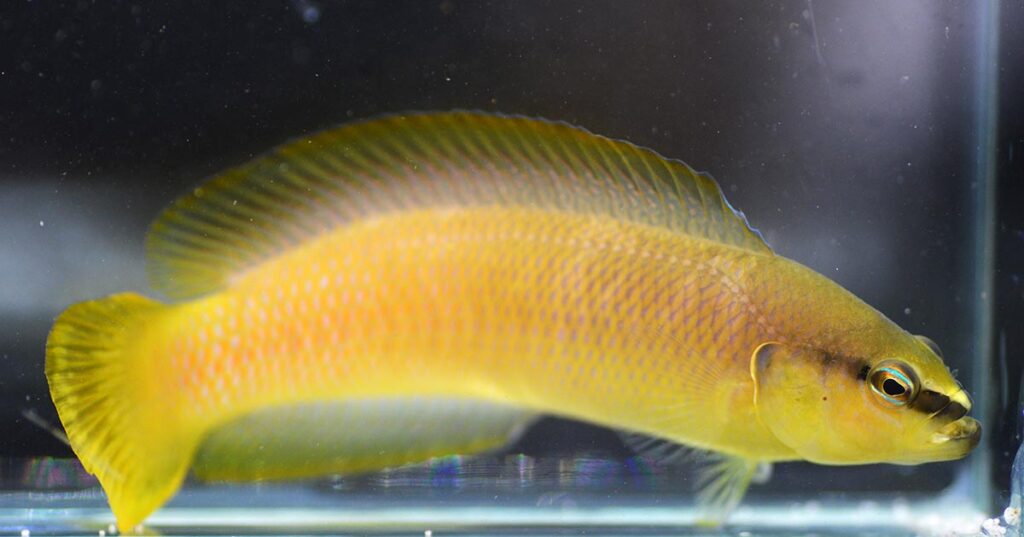
During unpacking we discovered beautiful yellow dottybacks with a white cap on their nose. As there are almost no pictures of P. omanensis we thought these fish may be that species, despite the reality that the fish we received did not really match the only three images we found for P. omanensis. De Jong Marinelife’s Director, Arie de Jong, has a rare, old book; Coastal Fishes of Oman, by John E. Randall, which he brought to the facility. It was there, in those pages, that we found the real identity of our mystery dottybacks —a powerful demonstration of the importance of reliable books!
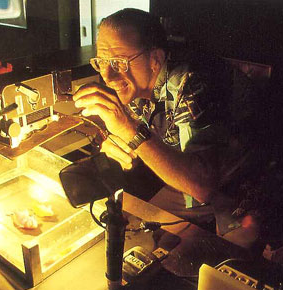
There was just one picture that showed the fish we had received; Pseudochromis leucorhynchus. The species was described in 1977. According to references, it inhabits crevices and holes on shallow inshore reefs and is usually found between depths of 1 to 8 meters (3 to 25 feet) where it feeds on smaller fishes and crustaceans. As far as we know there are only a few photographs of this species. Based on these rare photos, which are not very representative of the fish, the species is described in other books and articles as, “Has a dull overall brown body with a darker brown edging on body scales and a dark brown bar from the front edge of the snout through the eye.” In fact, our specimens are bright yellow with subtle edges of pink around the scales, a black bar through the blue eye, and an almost luminous white cap on their nose. Therefore, the common names of White Cap or White Nose Dottyback are particularly appropriate.
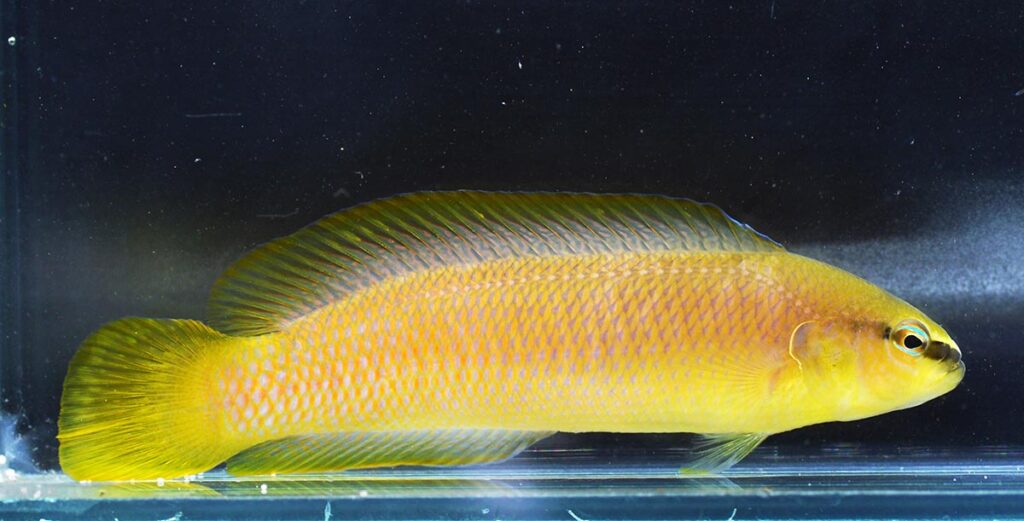
Upon arrival, our new dottybacks were quarantined and subsequently transferred to our breeding department. It didn’t take long before they started mating and spawning. As pairs, the male and female can be aggressive toward each other, something we also see with other dottybacks. However, they are completely safe to other fish. We maintain pairs of this species in small broodstock tanks, but also in several show tanks where the mind their own business. The average size of our broodstock is between 6 to 8 cm (2.4 to 3.1 inches). The females are slightly smaller than their male counterparts, both otherwise there are no major differences between the sexes.
As we were still in a construction phase at the hatchery, the first clutches where left with the broodstock. When our new larval systems where running, we conducted our first larval rearing run with this species, which was immediately successful. For this species, we use black round tubs of approximately 90 liters (24 gallons) for larval rearing tanks. The eggs were gathered from their parents and incubated in a small tumbler housed inside the larval rearing tank. After hatching on February 22, 2023, the larvae were kept in greenwater, and recirculation was on from day 1. The water was maintained around 28 C (84 F) with a specific gravity of around 1.021. We use LED lights for illumination with a photoperiod of 16:8 (light:dark). For their first 10 days post hatch (DPH), the larvae where fed with enriched rotifers and Acartia tonsa copepod nauplii. At 11 DPH, they started eating Artemia nauplii and more adult copepods.

Metamorphosis started at 15 DPH, which is a little bit faster as we see with other dottybacks. By 17 days, all larvae were through metamorphosis and had a bright yellow coloration. The only difference is the color of the eye which is red with these small juveniles. From this point, they were already good hunters and chasing after the benthic copepods in their larval tub. Hiding shelters was highly appreciated. At 23 DPH, they were moved to our grow-out section.
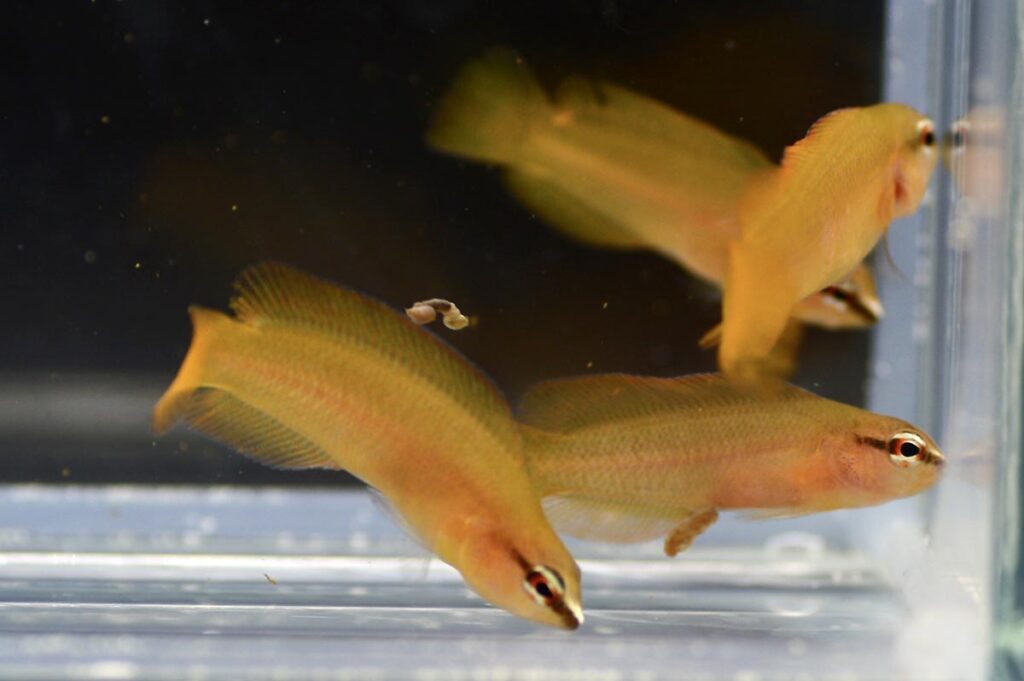
We know this fish is a subtle species and will never become as popular as the gaudy or classic species we breed like Pseudochromis fridmani or Amphiprion ocellaris. However, we think this species is currently underappreciated due to the simple reason that no one really even knows it exists! We really enjoy our broodstock. They offer interesting behavior and are a beautiful, strong species that can thrive in any reef tank. We will continue breeding this species to ensure its continued existence in the aquarium trade. It would be a shame if this species now just becoming available, would be lost to the hobby in the future.

